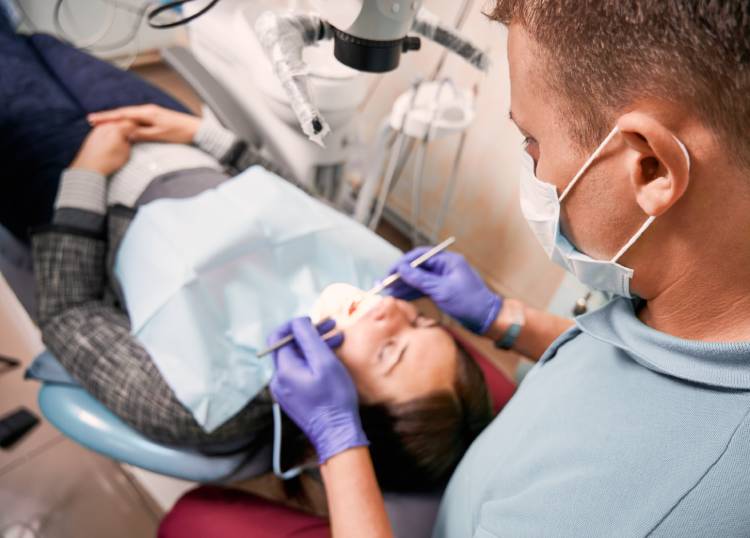In this blog, we explain what swelling from a tooth infection really means, why it happens, when it becomes an emergency, and what you can safely do at home before you reach a dentist. We’ll also cover the professional treatments that actually cure the problem and how to prevent future flare-ups. Throughout, you’ll see why prompt, skilled care, through emergency dentistry when needed, is the only reliable way to reduce swelling from tooth infection for good.

What is Swelling from a Tooth Infection?
A tooth infection (tooth abscess) forms when bacteria enter the pulp of a tooth or the surrounding gum and bone, creating a pocket of pus. Your immune system reacts, and nearby tissues, often the cheek or jawline, become inflamed, leading to facial swelling and throbbing pain. This isn’t just a nuisance: an untreated abscess won’t resolve on its own and needs dental care to prevent complications. Swelling is your body’s alarm bell. At the same time, simple measures can temporarily calm symptoms and reduce swelling from tooth infection; the source is fixed only by drainage and dental treatment, typically an emergency root canal or, in some cases, extraction.
What Causes Swelling from a Tooth Infection?
- Deep tooth decay, cracked teeth, or failed fillings that let bacteria reach the pulp
- Gum disease and impacted teeth that trap bacteria and food debris
- Trauma to a tooth that kills the pulp over time
- Reduced immunity (e.g., specific medical treatments) that increases risk or speed of spread
Read more: “When Do You Need a Dental Emergency?”
When Must You See a Dentist Immediately?
Get urgent dental care now if you notice any of the following:
- Fever, malaise, or rapidly worsening swelling
- Difficulty swallowing, breathing, or opening your mouth
- Swelling extending toward the eye
- Spreading redness or cellulitis of the face/neck
- A bad taste in your mouth with constant, severe pain
Read more: “Find the Best Dentist Near You in Oakville”
Effective At-Home Relief Methods for Swelling
Short-term home measures can reduce swelling from tooth infection and discomfort, but they do not cure the disease. Use them on your way to the dentist, not as an alternative to going; definitive treatment is dental. Medication alone won’t eliminate the source.
Cold compress
Apply to the cheek in 10–15 minute intervals to help reduce swelling from tooth infection and pain. Avoid heat; it can worsen the spread.
Over-the-counter pain relievers
Ibuprofen or acetaminophen can control pain and inflammation (avoid aspirin in children; follow label directions and your doctor’s advice). Remember, painkillers don’t cure the cause or permanently reduce swelling from tooth infection.
Gentle oral hygiene
Use a soft brush to clean the area carefully, and opt for smooth, lukewarm foods. Good oral hygiene minimizes irritation while you arrange care.

Professional Treatments That Actually Work
Only a dentist can definitively remove the cause of an infection and reduce swelling from tooth infection. Depending on your diagnosis, treatment may include:
- Abscess drainage to relieve pressure and decrease swelling
- Root canal therapy (endodontic treatment) to clean and seal the infected pulp space, saving the tooth when possible
- Tooth extraction if the tooth cannot be saved
- Antibiotics, when there are systemic signs (fever, diffuse swelling, malaise) or specific risks, are not a standalone fix
Read more: “Types of Dental Trauma: Causes, Symptoms, and Treatments”
Ready to Get Out of Pain?
Call SmilePoint Dental for a same-day assessment. Whether it’s Emergency Dental Repair in Oakville, Emergency Root Canal Therapy, or ongoing Oral Hygiene and preventive care, we’re here to help you heal fast and protect your smile long-term.
Preventing Future Swelling and Tooth Infections
Prevention beats emergency care. Routine prevention stops minor problems from becoming abscesses.
Daily Habits:
Brush twice daily with fluoride toothpaste and use floss or interdental brushes. Replace your toothbrush every 1–3 months and avoid rinsing with water immediately after brushing, so fluoride can continue to work and help reduce the risk of swelling from tooth infections.
Regular Check-ups:
Routine exams and cleanings help detect early decay, cracks, or gum disease before they develop into more severe infections. Back-to-school and periodic checkups help prevent issues from disrupting life and consistently reduce swelling associated with tooth infection risks over time.
Lifestyle:
Limit sugary snacks and drinks, avoid smoking, and manage stress (clenching and grinding can exacerbate inflammation). Good sleep and hydration aid healing after procedures and help reduce swelling from tooth infection recurrence.

Read more: “Tooth Abscess: Diagnosis and Treatment”
Choosing the Right Care: Home Remedies or Professional Treatment?
Swelling from a tooth infection signals active inflammation and often a developing abscess that won’t resolve without proper dental treatment. While home remedies can temporarily reduce swelling from tooth infection, they can’t cure the underlying cause. Seek urgent care if swelling affects breathing or swallowing, moves toward the eye, or you develop fever or malaise.
Definitive care may involve drainage, root canal therapy, or extraction; antibiotics are reserved for systemic spread or specific risks. Suppose you’re dealing with a swollen face or severe tooth pain today. In that case, a professional Dental Office in Oakville can help, offering same-day assessments, emergency dental repair in Oakville, and comfortable Oral Surgery. We also provide preventive care, gentle tooth extractions, always prioritizing your comfort and long-term oral health while reduce swelling from tooth infections safely and effectively.
FAQ
1. What’s the fastest way to reduce swelling from tooth infection at home?
Use a cold compress in short intervals and take appropriate OTC pain relievers if safe for you, then see a dentist promptly. Home measures only ease symptoms; definitive treatment is required to reduce swelling caused by tooth infection.
2. Will antibiotics alone fix a tooth abscess?
Usually no. Evidence-based guidance recommends dental treatment first. Antibiotics are added when there are systemic signs or high-risk conditions to help control the spread and ultimately reduce swelling from the tooth infection, in conjunction with procedures.
3. How can check-ups prevent future abscesses?
Routine exams catch early problems before bacteria reach the nerve. Booking regular cleanings and exams helps reduce the risk of swelling from tooth infections by addressing issues early.
Have you ever dealt with a tooth infection?What steps did you take to reduce swelling from tooth infection and manage the pain? Share your experience and tips in the comments!





